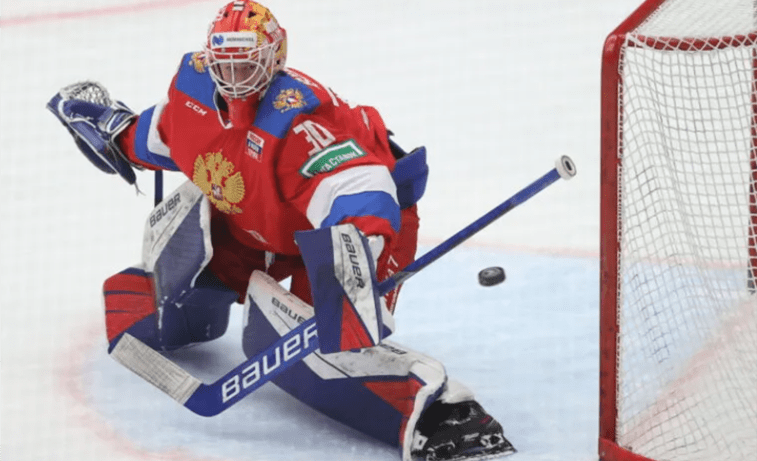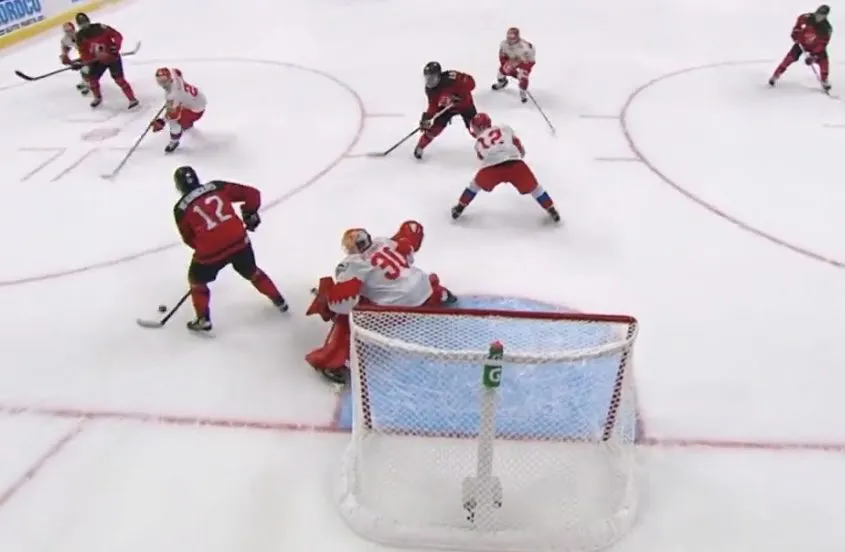McKenna and Quadrelli: Diagnosing the problem with Yaroslav Askarov

Let’s make three things clear right off the bat with this article.
First, you don’t start for SKA of the KHL as a teenager if you’re a bad goaltender.
You also don’t get drafted in the first round of the NHL Draft if you’re a bad goaltender, either.
Lastly, this article certainly isn’t being written just because of Askarov’s poor performance at the World Juniors, either. This is a prospect goaltender with legitimate technical flaws that we’ve been discussing and talking about since before he was even drafted.
Russian netminder Yaroslav Askarov has plenty of raw tools and intangible assets, but as his game currently stands, we think he’s got lots of work to do before he’ll ever find success in North America.
To break this down further, I conducted a Q&A with former NHL goaltender Mike McKenna. Here is how that conversation went down.
Quadrelli: I think the biggest thing with Askarov that I noticed as a deficiency in his draft year is his wide stance. The last goalie with a stance that wide that found success in the NHL was Matt Murray, if memory serves correct — but as the league shifted to a more East-West style of offense, he was left behind.
McKenna: Good eye, David. I harken back to Kari Lehtonen as the last example of someone that found success with such a low, wide stance. Murray, yes to a certain extent. But there’s more going on with him than just his stance. Askarov’s freakishly wide stance is his biggest detriment.
Quadrelli: And the hands I noticed, too. He seems to be kind of all over the place and pucks just don’t tend to stick to him. What do you attribute this to?
McKenna: I think a lot of it goes back to his stance. He’s so low and wide that his game is built on blocking more than reacting. Askarov is constantly sliding into shots on his knees, which means his eyes are constantly in motion laterally. That doesn’t equate to tracking the puck well. If he was more patient and upright, it would allow him to get his eyes on pucks earlier, and from a static position.
That’s one of the problems with his stance. Askarov isn’t a very good skater from what I’ve seen. He’s a good pusher. He’s constantly pushing on his knees and into butterfly slides. Yes, his width is freakish. It covers the bottom of the net. But it prevents him from doing so many things.
Quadrelli: What needs to change about this stance most of all?

McKenna: Askarov is going to have to bring his feet closer together, narrow up, play a little deeper and present his torso. Right now he’s a 6’x3′ blocking surface to shots. And a sitting duck backdoor.
Quadrelli: What are some deficiencies this stance will cause?
McKenna: The obvious one is that Askarov gives away the top of the net to shooters. He’s 6-foot-2, but plays like he’s 5-foot-10. His goalie posture is worrisome. Successful NHL goaltenders present big and you can see the crest on the front of their jersey.
Quadrelli: Now, he’s clearly got the raw tools and some of the intangible assets goalie coaches dream of. You don’t get to start for SKA at that age unless you’re doing something right. Do you think playing behind a solid team like SKA has kind of boosted his save percentage since teams aren’t really able to get many second chances on rebounds he gives up after simply “blocking” the puck?
McKenna: Oh, definitely, playing on SKA has helped raise his stock. He’s so young — it’s impressive he’s been one of their goalies the past few years. But compare his numbers to the other SKA goalies. There isn’t a big delta. And he hasn’t played a lot of hockey. 15 games in the past three seasons isn’t a big enough sample size to judge anything.
I don’t know enough about the Russian game to comment on the rebound aspect. But it’s very real in international competition and it will be when he makes the jump to the AHL. Askarov will have to become more active in using his chest and hands to control pucks. Because right now he’s not dynamic.
At this rate, I can’t imagine him going straight to the NHL. Even Igor Shesterkin started with AHL-Hartford and had to prove his merit. Yes, Ilya Sorokin went straight to the Islanders. But he was older when he came over at age 24. And he had leverage. Sorokin had zero intentions of playing in the AHL.
His freakishly wide, low stance prevents Askarov from being able to rotate. When your edges are locked into the ice, it’s nearly impossible to rotate before pushing. And what happens is Askarov can only move laterally in straight lines.
Quadrelli: What did he do wrong on this goal?
Lukas Cormier makes it 4-0 with a powerplay goal! 🇨🇦 pic.twitter.com/7xuxRokjAR
— TSN (@TSN_Sports) December 24, 2021McKenna: On this goal, I think his initial depth is too aggressive. Playing at the top of the blue crease on a penalty kill makes it difficult to cover the distance necessary for any lateral movement. Which is what North American power plays are all about.
Askarov isn’t patient when the puck goes down low to the Canadian player and he leaves his feet early. There is no shot threat, but he drops regardless. This is where his width hurts him — you can see him physically struggle to rotate in time to move across. If his butterfly was narrower — with his knees closer together — he would have had a chance. Instead, he’s locked in and can’t move laterally in time.
Ideally, his movement would be to the far post. Instead, his plane of motion is way in front of the post, because he lacked the ability to rotate.
Quadrelli: Now, these issues with Askarov- they all seem to be things that are relatively coachable and fixable, right?
McKenna: Maybe. I’d hope so.
Askarov is only 19 years old and has plenty of runway ahead of him. The Predators — and goaltending coach Ben Vanderklok — did a fantastic job of developing Juuse Saros.
There are moments where I can tell Askarov is trying to play more vertically. I think he’s aware of it. But ultimately he reverts to old habits. Whenever Askarov arrives in North America, he will be in good hands. Predators Goaltending Development Coach Dave Rook is excellent. Coaching professional goaltenders is more about breaking habits than it is teaching new techniques. And there are plenty of fellow Russian goalies in the NHL that Askarov can look to as a rubric.
Quadrelli: Can you think of a goalie prospect who looked this out of sorts but figured it out once turning pro? In particular, a first-round pick?
McKenna: That’s a really hard one, because usually goaltenders get to pro and have their wake-up call moment that it’s not going to be as easy as they thought making it to the NHL.
I think of goalies like Al Montoya, who was drafted way higher than he ever should have been. I’m still surprised he had the career he did. The University of Michigan was so good back then and he reaped the benefits of it. Teams didn’t use to have a clue when it came to evaluating goalies. But Al kept working and eventually, things clicked — seven years after he was drafted.
Quadrelli: What advice would you give Askarov? And what should his mindset be like coming to North America?
A: When he gets to North American, Askarov should be studying NHL goaltenders — especially his fellow Russian netminders like Shesterkin, Vasilelskiy, and Sorokin.
When Vasy first came over, he played incredibly wide and low. Over time he’s become more upright and done a better job of presenting big without losing his signature athleticism. He needs to speak English, and he needs to be a sponge. Dave Rook and Ben Vanderklok have a history of developing goaltenders — listen to them! He’s such a high draft pick that the Predators will do everything they can to not let him fail. He’ll get second and third chances where a later pick might get one. If he’s lucky. So it behooves Askarov to be patient. And a good student.